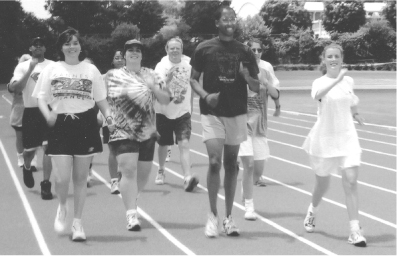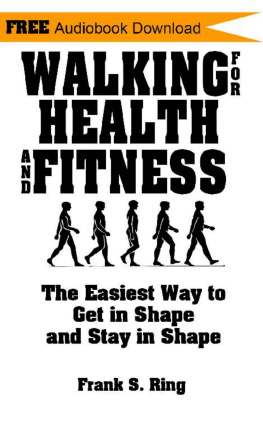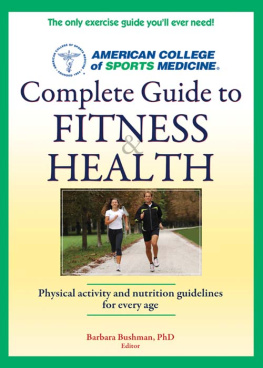Kathryn L Davis - Fitness Walking Everyone
Here you can read online Kathryn L Davis - Fitness Walking Everyone full text of the book (entire story) in english for free. Download pdf and epub, get meaning, cover and reviews about this ebook. year: 2013, publisher: Hunter Textbooks, genre: Romance novel. Description of the work, (preface) as well as reviews are available. Best literature library LitArk.com created for fans of good reading and offers a wide selection of genres:
Romance novel
Science fiction
Adventure
Detective
Science
History
Home and family
Prose
Art
Politics
Computer
Non-fiction
Religion
Business
Children
Humor
Choose a favorite category and find really read worthwhile books. Enjoy immersion in the world of imagination, feel the emotions of the characters or learn something new for yourself, make an fascinating discovery.
- Book:Fitness Walking Everyone
- Author:
- Publisher:Hunter Textbooks
- Genre:
- Year:2013
- Rating:5 / 5
- Favourites:Add to favourites
- Your mark:
- 100
- 1
- 2
- 3
- 4
- 5
Fitness Walking Everyone: summary, description and annotation
We offer to read an annotation, description, summary or preface (depends on what the author of the book "Fitness Walking Everyone" wrote himself). If you haven't found the necessary information about the book — write in the comments, we will try to find it.
Fitness walking has become a very popular fitness activity at many colleges and universities across the nation. This book has been specifically written for college level fitness classes.
Fitness Walking Everyone — read online for free the complete book (whole text) full work
Below is the text of the book, divided by pages. System saving the place of the last page read, allows you to conveniently read the book "Fitness Walking Everyone" online for free, without having to search again every time where you left off. Put a bookmark, and you can go to the page where you finished reading at any time.
Font size:
Interval:
Bookmark:
Fitness Walking
Everyone
3rd Edition
Kathryn L. Davis
Winthrop University
2013 by Hunter Textbooks Inc.
ISBN 978-088725-352-2
All rights reserved. No part of this publication may be reproduced, stored in a retrieval system, or transmitted in any form or by any means, electronic, mechanical, photocopying, recording or otherwise, without prior written permission of the publisher.
Inquiries should be addressed to:

701 Shallowford Street
Winston-Salem, NC 27101
Additional copies of this book may be purchased through our World Wide Website at www.huntertextbooks.com.
Preface
To The Third Edition
This book is the latest version of my career-long effort to promote physical education activities for healthy lifestyles. Fitness walking has become a very popular fitness activity across the United States as a way to exercise for disease prevention, for leisurely lifetime activity, and for obesity prevention. Fitness walking class sections have emerged and thrived at many colleges and universities across the nation. This book has been specifically written for college level fitness classes, but it has great applicability to K-12 physical education programs and teachers. This edition has been updated to include more recent technologies and information to be helpful for the reader. Fitness Walking Everyone will assist walkers of any age and gender to learn the necessary skills and concepts for a lifetime of walking enjoyment.
Since the first edition was published in 1997, the obesity epidemic has intensified particularly for children. Half of obesity can be attributed by poor nutrition, but the other half is directly related to a lack of exercise particularly moderate to vigorous exercise. Fitness walking is an enjoyable type of exercise that anyone can do easily, and it fulfills one of the components of health-related fitness: cardiovascular endurance. The other four components are discussed in detail in the chapters on muscular strength, muscular endurance, flexibility, and body composition. These are the four additional components that should be incorporated into any fitness walking program. In addition to the five components of fitness, the contemporary concept of wellness is defined and discussed in relation to fitness walking. This edition also retains many of the teaching ideas and explanations of the walking techniques of the first edition, including descriptions of several walking programs to guide beginning walkers in starting a personal walking program.
A chapter is included at the end of the book to provide teachers with some ideas and methods for teaching fitness walking in schools and colleges. As in the first edition, several learning aids are included in the Appendices as supplementary materials for the text. After discovering the many benefits of walking, it is obvious that fitness walking can make a significant contribution to a healthy lifestyle.
AUTHORS NOTE: In an attempt to be gender equitable, the pronouns he/she will be used in the first half of the book, and she/he will be used in the second half of the book.
Dedication
To the memory of my aunt,
Aurelia Davis,
who dedicated her life to teaching
students with special needs.
Acknowledgments
The author would like to thank the following people for their gracious contributions in preparing this book:
Terri Alphin, Harold Barnes, Cheryl Davis, Tom Harless, Cerine Hill, Lora Jones, Ginny Leath, Ricky Livingston, Sarah Martensen, Nikki Martin, Eric McBride, Timothy Murphy, Betsy Murray, Nicole Omiatek, Chris Pegues, Nicole Rhodes, Harrie Schoots, Robin Suka, Peggy Upchurch, Mary Vicente, and Barbara Weathington.
Chapter One
Walking as a Fitness Activity
W alking is a recreational activity for enjoyment and pleasure, and it can be an activity used to improve cardiovascular endurance. Even though walking is the most popular exercise in America today, most people do not realize what it can do for the body. Researchers have taken a closer look at walking, and they have discovered that this enjoyable exercise can help people lose weight, build aerobic fitness, reduce the risk of heart disease, tone the muscles, increase flexibility, and reduce stress.
Popularity of Walking
Why has walking become such a popular activity? It is a simple activity that people of all ages and fitness levels can enjoy. There are no special skills required to be able to walk. Its low-impact nature makes it one of the safest and most effective forms of exercise that produces fitness and health benefits. Fitness walking is now performed by about 80 million Americans.

Figure 1.1. Walking is a Popular Activity

Figure 1.2. College Walking Clubs are Common
During the fitness boom of the 1970s and 1980s, walking was never accepted as a serious form of exercise. It was always viewed as a leisure activity, and not an intense fitness activity that could lead to health benefits. However, it has been proven that fitness walking does raise the heart rate sufficiently to achieve fitness gains.
Evidence of the increased popularity of walking can be found in the growing trend among colleges and universities that offer fitness walking courses for credit. Over 100 institutions of higher learning offer some type of walking course. Walking clubs have also become prevalent at the college level, as more students have a need to walk with a partner or group for motivation and social support. One of the goals of these walking clubs is to prepare the members to enter walking events. These events usually have either a 5-kilometer or 10-kilometer course for the competition, but that distance varies between events. The number of racewalking events is also increasing. Since 1908, racewalking has been an Olympic sport. Even though racewalking would be considered the most advanced level of walking, clubs for racewalkers have become very popular in cities across America. These walking clubs are a healthy way to share a social and physical activity with others in the community.
Types of Walking
There are many different names that are used to describe the different types of walking, depending on the speed and the environment in which a person walks. Each of these types of walking represent different levels of intensity. The following five categories are based on the speed of walking:
- Intermittent Walking (1-2 mph): Walking which is done to accomplish everyday activities, such as office work, yard work, and shopping. It would be considered anaerobic and it provides little cardiovascular benefit.
- Strolling (2 mph): This is considered casual walking, done at an easy pace. Strolling is excellent for those recovering from illness, or for someone who has been sedentary and wants to start a walking program. Strolling does not have enough intensity for an aerobic training effect, but it can burn calories and help circulate the blood.
- Fitness Walking (3-4 mph): Walking which is done to improve ones fitness level by walking often enough, hard enough, and long enough to achieve fitness gains. It is performed by using a longer, faster, more purposeful stride and arm swing. This speed is sufficient to elevate the heart rate to the desirable aerobic training zone, and to maintain it throughout the workout.
Font size:
Interval:
Bookmark:
Similar books «Fitness Walking Everyone»
Look at similar books to Fitness Walking Everyone. We have selected literature similar in name and meaning in the hope of providing readers with more options to find new, interesting, not yet read works.
Discussion, reviews of the book Fitness Walking Everyone and just readers' own opinions. Leave your comments, write what you think about the work, its meaning or the main characters. Specify what exactly you liked and what you didn't like, and why you think so.





